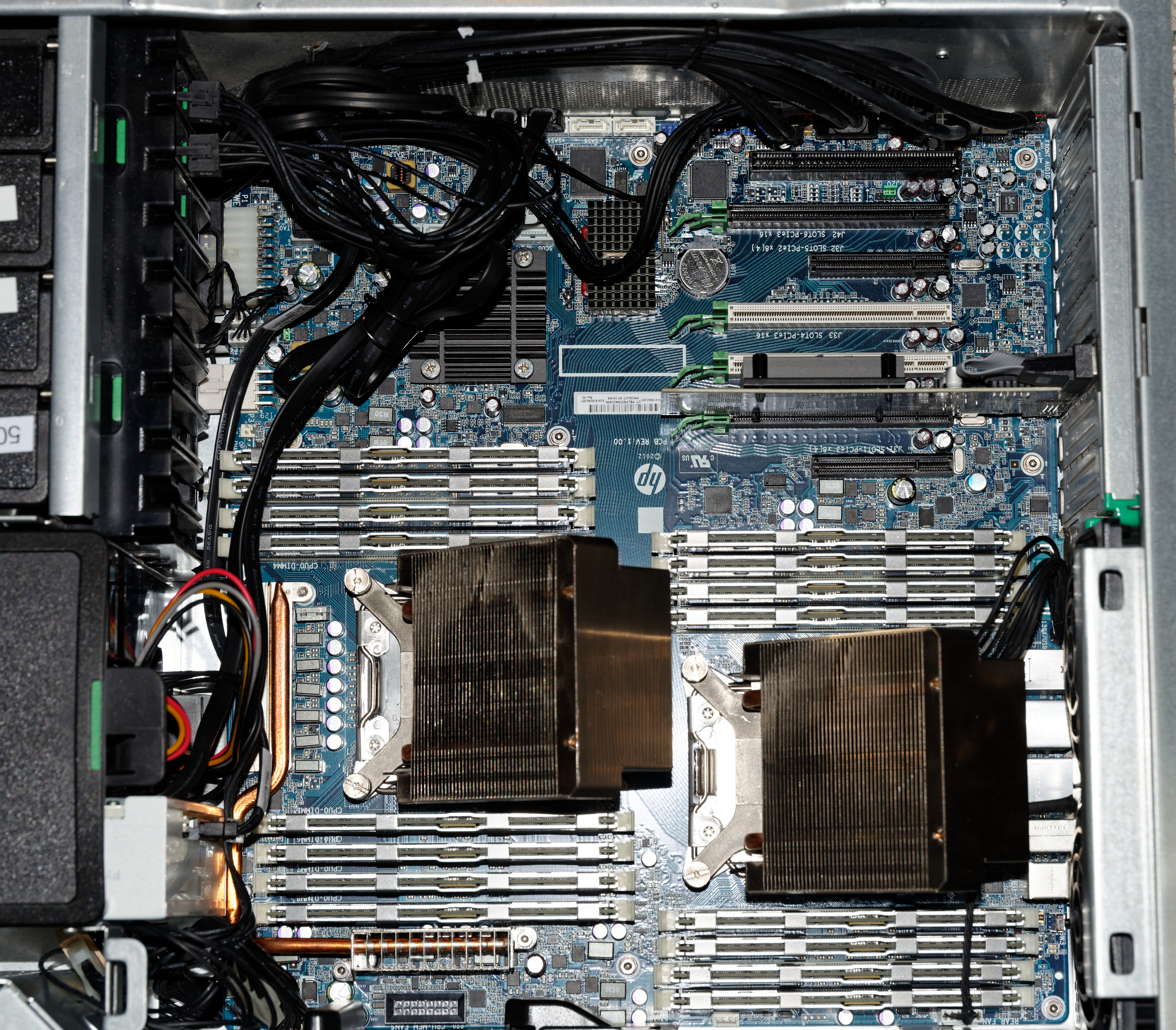|
Hewlett Packard Labs
Hewlett Packard Labs is the exploratory and advanced research group for Hewlett Packard Enterprise and its businesses. It was formed in November, 2015 when HP Labs spun off Hewlett Packard Labs to reflect the spin off of Hewlett Packard Enterprise from HP Inc. (formerly Hewlett-Packard). The lab is located in Palo Alto, California. History HP Labs was established on March 3, 1966, by founders Bill Hewlett and David Packard, seeking to create an organization not bound by day-to-day business concerns. In August 2007, HP executives drastically diminished the number of projects, down from 150 to 30. On November 1, 2015, HP Labs spun off Hewlett Packard Labs into a separate organization managed by Hewlett Packard Enterprise with Martin Fink becoming the director. In 2014, CTO Martin Fink Labs announced a computer architecture research project called The Machine. The project focused on a "memory-centric" computer based on a pool of non-volatile memristor memory connected to specia ... [...More Info...] [...Related Items...] OR: [Wikipedia] [Google] [Baidu] |
Hewlett Packard Enterprise
The Hewlett Packard Enterprise Company (HPE) is an American multinational information technology company based in Spring, Texas, United States. HPE was founded on November 1, 2015, in Palo Alto, California, as part of the splitting of the Hewlett-Packard company. It is a business-focused organization which works in servers, storage, networking, containerization software and consulting and support. The split was structured so that the former Hewlett-Packard Company would change its name to HP Inc. and spin off Hewlett Packard Enterprise as a newly created company. HP Inc. retained the old HP's personal computer and printing business, as well as its stock-price history and original NYSE ticker symbol for Hewlett-Packard; Enterprise trades under its own ticker symbol: HPE. At the time of the spin-off, HPE's revenue was slightly less than that of HP Inc. In 2017, HPE spun off its Enterprise Services business and merged it with Computer Sciences Corporation to become DXC Te ... [...More Info...] [...Related Items...] OR: [Wikipedia] [Google] [Baidu] |
HP Inc
HP Inc. is an American multinational information technology company headquartered in Palo Alto, California, that develops personal computers (PCs), printers and related supplies, as well as 3D printing solutions. It was formed on November 1, 2015, renamed from the personal computer and printer divisions of the original Hewlett-Packard Company, with that company's enterprise product and business services divisions becoming Hewlett Packard Enterprise. The split was structured so that Hewlett-Packard changed its name to HP Inc. and spun off Hewlett Packard Enterprise as a new publicly traded company. HP Inc. retains Hewlett-Packard's pre-2015 stock price history and its former stock ticker symbol, HPQ, while Hewlett Packard Enterprise trades under its own symbol, HPE. HP is listed on the New York Stock Exchange and is a constituent of the S&P 500 Index. It is the world's 2nd largest personal computer vendor by unit sales as of January 2021, after Lenovo. In the 2018 ... [...More Info...] [...Related Items...] OR: [Wikipedia] [Google] [Baidu] |
HP Labs
HP Labs is the exploratory and advanced research group for HP Inc. HP Labs' headquarters is in Palo Alto, California and the group has research and development facilities in Bristol, UK. The development of programmable desktop calculators, inkjet printing, and 3D graphics are credited to HP Labs researchers. HP Labs was established on March 3, 1966, by founders Bill Hewlett and David Packard, seeking to create an organization not bound by day-to-day business concerns. The labs have downsized dramatically; in August 2007, HP executives drastically diminished the number of projects, down from 150 to 30. As of 2018, HP Labs has just over 200 researchers, compared to earlier staffing levels of 500 researchers. With the Hewlett Packard Enterprise being spun off from Hewlett-Packard on November 1, 2015, and renamed to and HP Inc., the research lab also spun off Hewlett Packard Labs to Hewlett Packard Enterprise and HP Labs was kept for HP Inc. History As the Semiconductor Lab's f ... [...More Info...] [...Related Items...] OR: [Wikipedia] [Google] [Baidu] |
Palo Alto, California
Palo Alto (; Spanish for "tall stick") is a charter city in the northwestern corner of Santa Clara County, California, United States, in the San Francisco Bay Area, named after a coastal redwood tree known as El Palo Alto. The city was established in 1894 by the American industrialist Leland Stanford when he founded Stanford University in memory of his son, Leland Stanford Jr. Palo Alto includes portions of Stanford University and borders East Palo Alto, Mountain View, Los Altos, Los Altos Hills, Stanford, Portola Valley, and Menlo Park. At the 2020 census, the population was 68,572. Palo Alto is one of the most expensive cities in the United States in which to live, and its residents are among the most educated in the country. However, it also has a youth suicide rate four times higher than the national average, often attributed to academic pressure. As one of the principal cities of Silicon Valley, Palo Alto is headquarters to a number of high-tech companies, in ... [...More Info...] [...Related Items...] OR: [Wikipedia] [Google] [Baidu] |
Vice President
A vice president, also director in British English, is an officer in government or business who is below the president (chief executive officer) in rank. It can also refer to executive vice presidents, signifying that the vice president is on the executive branch of the government, university or company. The name comes from the Latin term '' vice'' meaning "in place of" and typically serves as '' pro tempore'' (Latin: ’for the time being’) to the president. In some countries, the vice president is called the ''deputy president''. In everyday speech, the abbreviation ''VP'' is used. In government In government, a vice president is a person whose primary responsibility is to act in place of the president on the event of the president's death, resignation or incapacity. Vice presidents are either elected jointly with the president as their running mate, or more rarely, appointed independently after the president's election. Most governments with vice presidents have one ... [...More Info...] [...Related Items...] OR: [Wikipedia] [Google] [Baidu] |
Hewlett-Packard
The Hewlett-Packard Company, commonly shortened to Hewlett-Packard ( ) or HP, was an American multinational information technology company headquartered in Palo Alto, California. HP developed and provided a wide variety of hardware components, as well as software and related services to consumers, small and medium-sized businesses ( SMBs), and large enterprises, including customers in the government, health, and education sectors. The company was founded in a one-car garage in Palo Alto by Bill Hewlett and David Packard in 1939, and initially produced a line of electronic test and measurement equipment. The HP Garage at 367 Addison Avenue is now designated an official California Historical Landmark, and is marked with a plaque calling it the "Birthplace of ' Silicon Valley'". The company won its first big contract in 1938 to provide test and measurement instruments for Walt Disney's production of the animated film '' Fantasia'', which allowed Hewlett and Packard to forma ... [...More Info...] [...Related Items...] OR: [Wikipedia] [Google] [Baidu] |
Bill Hewlett
William Redington Hewlett ( ; May 20, 1913 – January 12, 2001) was an American engineer and the co-founder, with David Packard, of the Hewlett-Packard Company (HP). Early life and education Hewlett was born in Ann Arbor, Michigan, where his father taught at the University of Michigan Medical School. In 1916 the family moved to San Francisco after his father, Albion Walter Hewlett, took a similar position at Stanford Medical School, located at the time in San Francisco. He attended Lowell High School and was the 1929-1930 Battalion Commander of the school's Army JROTC program. He was accepted at Stanford University as a favor to his late father who had died of a brain tumor in 1925. Hewlett received his bachelor's degree from Stanford University in 1934, a Master of Science degree in electrical engineering from MIT in 1936, and the degree of Electrical Engineer from Stanford in 1939. He joined the Kappa Sigma fraternity during his time at Stanford. Career Hewlett- ... [...More Info...] [...Related Items...] OR: [Wikipedia] [Google] [Baidu] |
David Packard
David Packard ( ; September 7, 1912 – March 26, 1996) was an American electrical engineer and co-founder, with Bill Hewlett, of Hewlett-Packard (1939), serving as president (1947–64), CEO (1964–68), and chairman of the board (1964–68, 1972–93) of HP. He served as U.S. Deputy Secretary of Defense from 1969 to 1971 during the Nixon administration. Packard served as president of the Uniformed Services University of the Health Sciences (USU) from 1976 to 1981 and chairman of its board of regents from 1973 to 1982. He was a member of the Trilateral Commission. Packard was the recipient of the Presidential Medal of Freedom in 1988 and is noted for many technological innovations and philanthropic endeavors. Personal life Packard was born in Pueblo, Colorado, the son of Ella (Graber) and Sperry Sidney Packard, an attorney. He attended Centennial High School, where early on he showed an interest in science, engineering, sports, and leadership. Packard earned his ... [...More Info...] [...Related Items...] OR: [Wikipedia] [Google] [Baidu] |
Non-volatile Memory
Non-volatile memory (NVM) or non-volatile storage is a type of computer memory that can retain stored information even after power is removed. In contrast, volatile memory needs constant power in order to retain data. Non-volatile memory typically refers to storage in semiconductor memory chips, which store data in floating-gate memory cells consisting of floating-gate MOSFETs ( metal–oxide–semiconductor field-effect transistors), including flash memory storage such as NAND flash and solid-state drives (SSD). Other examples of non-volatile memory include read-only memory (ROM), EPROM (erasable programmable ROM) and EEPROM (electrically erasable programmable ROM), ferroelectric RAM, most types of computer data storage devices (e.g. disk storage, hard disk drives, optical discs, floppy disks, and magnetic tape), and early computer storage methods such as punched tape and cards. Overview Non-volatile memory is typically used for the task of secondary storage ... [...More Info...] [...Related Items...] OR: [Wikipedia] [Google] [Baidu] |
Memristor
A memristor (; a portmanteau of ''memory resistor'') is a non-linear two-terminal electrical component relating electric charge and magnetic flux linkage. It was described and named in 1971 by Leon Chua, completing a theoretical quartet of fundamental electrical components which comprises also the resistor, capacitor and inductor. Chua and Kang later generalized the concept to memristive systems. Such a system comprises a circuit, of multiple conventional components, which mimics key properties of the ideal memristor component and is also commonly referred to as a memristor. Several such memristor system technologies have been developed, notably ReRAM. The identification of memristive properties in electronic devices has attracted controversy. Experimentally, the ideal memristor has yet to be demonstrated. As a fundamental electrical component Chua in his 1971 paper identified a theoretical symmetry between the non-linear resistor (voltage vs. current), non-linear capa ... [...More Info...] [...Related Items...] OR: [Wikipedia] [Google] [Baidu] |
Non-uniform Memory Access
Non-uniform memory access (NUMA) is a computer memory design used in multiprocessing, where the memory access time depends on the memory location relative to the processor. Under NUMA, a processor can access its own local memory faster than non-local memory (memory local to another processor or memory shared between processors). The benefits of NUMA are limited to particular workloads, notably on servers where the data is often associated strongly with certain tasks or users. NUMA architectures logically follow in scaling from symmetric multiprocessing (SMP) architectures. They were developed commercially during the 1990s by Unisys, Convex Computer (later Hewlett-Packard), Honeywell Information Systems Italy (HISI) (later Groupe Bull), Silicon Graphics (later Silicon Graphics International), Sequent Computer Systems (later IBM), Data General (later EMC, now Dell Technologies), and Digital (later Compaq, then HP, now HPE). Techniques developed by these companies later ... [...More Info...] [...Related Items...] OR: [Wikipedia] [Google] [Baidu] |



